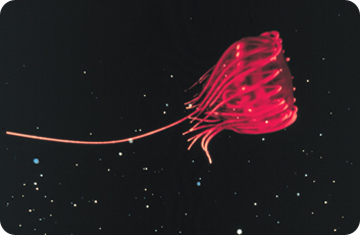A cherry red sports car passes by and catches everyone’s eye. A brilliant red hibiscus is a centerpiece in a lush tropical garden. It seems impossible for anything having a crimson hue to be inconspicuous. But that’s precisely what some marine animals are.
 A midwater jellyfish. Photo: M. Youngbluth - OAR/National Undersea Research Program (NURP); Harbor Branch Oceanographic Institution
A midwater jellyfish. Photo: M. Youngbluth - OAR/National Undersea Research Program (NURP); Harbor Branch Oceanographic InstitutionRed snapper, several kinds of rockfishes, and even some shrimps that live in moderately deep water are covered with red pigment. Yet in their natural habitat, they are virtually invisible.
The secret of their invisibility is water. The colors we see on an object are the colors that it reflects. White light that enters the ocean contains all of the colors, or wavelengths, we see and some we cannot see. But water absorbs red and yellow wavelengths much faster than green and blue wavelengths. By the time the light reaches the depths where these fishes live, the red light is absorbed and only blues or greens remain. Since the skin of these fishes does not reflect blue or green, there is nothing to see.
The same thing happens to the red cardinalfishes and squirrelfishes on coral reefs, even though the reefs are much shallower than the habitats where red snapper and rockfishes live. The red fishes on reefs are active by night when there is much less light available, and what little red light there is disappears near the surface.
The most common method of camouflage is to blend into the background by matching the coloration and pattern of the surroundings. Flatfishes do it, chameleons do it, and soldiers in khaki do it. Wearing a cloak of red underwater is a different way to hide.
Copyright 2007, The University of Texas Marine Science Institute


